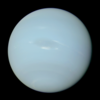ODINUS
Appearance
 Logo used in a mission proposal is a combination of the astronomical symbols for the planets Uranus and Neptune. | |
| Mission type | Orbiter |
|---|---|
| Operator | European Space Agency |
| Website | http://odinus.iaps.inaf.it/ |
| Spacecraft properties | |
| Dry mass | 500-600 kg |
| Start of mission | |
| Launch date | 2034 (proposed) |
| Neptune orbiter | |
| Spacecraft component | Freyja |
| Uranus orbiter | |
| Spacecraft component | Freyr |
ODINUS (Origins, Dynamics, and Interiors of the Neptunian and Uranian Systems) is a space mission concept proposed to the European Space Agency's Cosmic Vision programme. The ODINUS mission concept proposes to expand the Uranus orbiter and probe mission to two twin orbiters— dubbed Freyr and Freyja, the twin gods of the Norse pantheon.[1][2] Their primary mission would be to study Neptune and Uranus with one orbiter each.[3] If selected, ODINUS would launch in 2034.[4]
Instruments
[edit]The following six instruments are considered essential to the mission:
- Camera (Wide and Narrow Angle) – Designed to image the planet at the same level of detail as missions to the two gas giants have provided.
- VIS-NIR Image Spectrometer
- Magnetometer – To study the magnetic fields of Neptune.
- Mass Spectrometer (Ions and Neutrals, INMS)
- Doppler Spectro-Imager – To take seismic measurements.
- Microwave Radiometer
The following two additional instruments are strongly desired by the mission proposers:
- Energetic Neutral Atoms Detector – To complement the measurements of the INMS.
- High-sensitivity Accelerometer – To be used in the atmospheric descent phase.
See also
[edit]- Uranus mission proposals
References
[edit]- ^ The ODINUS Mission Concept. White paper submitted to the European Space Agency call for L2 and L3 science themes (2013). Diego Turrini, Romolo Politi, Roberto Peron, Davide Grassi, Christina Plainaki, Mauro Barbieri, David M. Lucchesi, Gianfranco Magni, Francesca Altieri, Valeria Cottini, Nicolas Gorius, Patrick Gaulme, François-Xavier Schmider, Alberto Adriani, Giuseppe Piccioni.
- ^ Turrini, Diego; Politi, Romolo; Peron, Roberto; Grassi, Davide; Plainaki, Christina; Barbieri, Mauro; Lucchesi, David M.; Magni, Gianfranco; Altieri, Francesca; Cottini, Valeria; Gorius, Nicolas; Gaulme, Patrick; Schmider, François-Xavier; Adriani, Alberto; Piccioni, Giuseppe (2014). "The ODINUS Mission Concept – The Scientific Case for a Mission to the Ice Giant Planets with Twin Spacecraft to Unveil the History of our Solar System". arXiv:1402.2472 [astro-ph.EP].
- ^ Noreika, Alius (13 February 2014). "Uranus and Neptune exploration could be the next ESA milestone". Technology.org. Retrieved 1 April 2016.
- ^ Gilster, Paul (18 June 2014). "Return to the Ice Giants". Centauri Dreams. Retrieved 1 April 2016.

